STA540 / TDA7375 DIY Guide - 38W / 35W Stereo Bridge / 13W Quad Single Chip Power Amplifiers
The STA540, TDA7375 (E-TDA7375V or E-TDA7375AV), TDA7377 (TDA7377V, TDA7377H or E-TDA7377) are all very capable amplifier chips of which many are still readily available as of August 2020. They allow you to easily build high performance stereo amplifiers, 2.1 amplifiers or Quad channel amplifiers.
Recommended Experience : Beginner to Intermediate, knowledge of amplifiers, heatsink attaching
STA540 application
Quick facts STA540
- Power output: 2x 34W into 8 ohms at 10% 1kHz distortion with power supply 22V
- Power output: 2x 38W into 4 ohms at 10% 1kHz distortion with power supply 18V
- Power output: 4x 7W into 8 ohms at 10% 1kHz distortion with power supply 22V
- Power output: 4x 11W into 4 ohms at 10% 1kHz distortion with power supply 18V
- Power output: 2x 18W into 8 ohms at 1% 1kHz distortion with power supply 18V
- Power output: 2x 8W into 8 ohms at 1% 1kHz distortion with power supply 12V
- Gain: 26dB fixed in bridge mode, 20dB fixed in single ended mode
- Power supply: 8V to 22V single supply
- Class AB
- Datasheet available here
Guide
The STA540 is a simple to build amplifier that has the flexibility to operate in stereo/dual mode, 2.1 mode or as a quad channel amplifier that can deliver a very good power output into both 8 ohm and 4 ohm speakers from just a single rail power supply of 12V, and even more power when supplied with around 18V or more.
The STA540 is specifically intended to operate in high quality sound systems, but has a wide range of possibilities:
- It is a capable amp for a stereo system (i.e. a homemade or upgraded midi system or 'ghetto-Blaster')
- A single chip can be used to make a 2.1 system - an active subwoofer and two smaller satellite speakers
- A single chip can make a surround sound system (i.e. front and rear channel amps)
- Decent quality PC speakers - either large stereo, or 2.1 stereo/sub combination
- Stereo or Bi-amplified Bluetooth speaker
- Bi-amplified stereo sound system
- ICE - in car entertainment system, though TDA7375/TDA7377 are more suitable
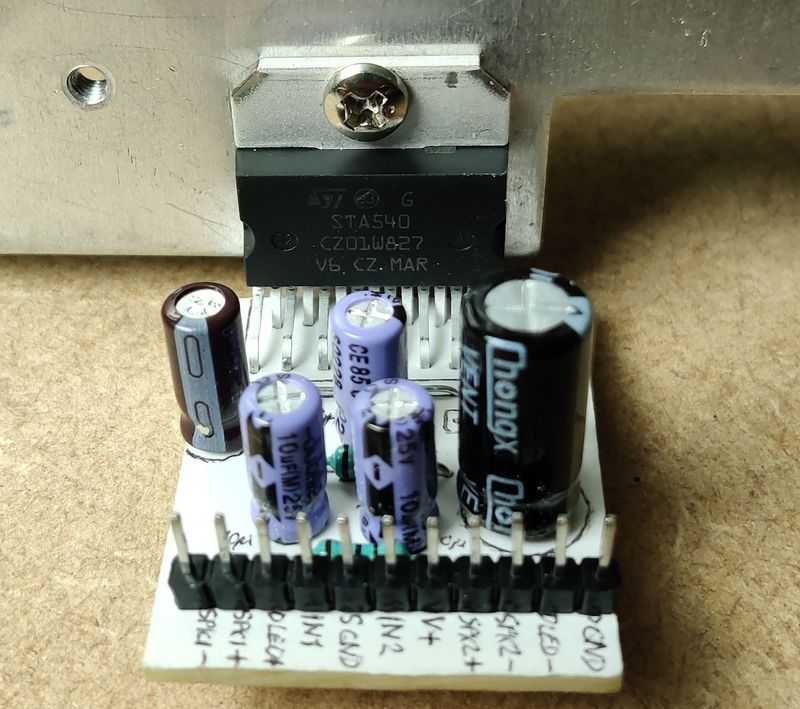
The information here is based on the typical application circuits in the ST Microelectronics datasheet. The performance from this circuit is excellent. The sheet contains data for typical noise and distortion statistics and whilst I can't confirm these statistics, I can confirm it sounds excellent!
Because of its ability to go to quite a high power, it's suitable for an absolutely vast variety of applications, from small systems to quite powerful hifi applications, without the need to build dual rail power supplies of high voltages. If you're a beginner wanting to build a decent hifi system, this is probably the chip to build with.
For lower power applications, you may want to consider the TDA7266 or TDA7297 chips instead, as they are cheaper, require less components and will operate down to 3V and 6V respectively. Unlike the STA540 and others here though, they only give the dual bridge options.
Unlike the TDA7297 / TDA7266, this chip can operate into 4 ohm speakers in its bridge mode. In quad mode, it can also drive 2 ohm speakers, but I see that as a very niche requirement to be driving 4x 2 ohm speakers. If you need to drive 2 ohm speakers with a bridge, consider the TDA7376 (dual), or TDA7396 (single).
If you are driving 2x 4 ohm speakers in bridge mode, do not give a power supply more than 18V. With 2x 8 ohm speakers, you can push the voltage up to 22V for the STA540.
For those whose application really doesn't need a dual/stereo amplifier (and bi-amplification would not be any consideration), there are mono alternatives TDA7391 and TDA7396, and although both are aimed at Car Radio applications, they'll still sound good.
Note that because the STA540 already has two bridged outputs, you cannot bridge them again to make a (say) 68W amp. An amplifier can only be bridged once. A parallel bridge configuration (which would allow driving lowing impedance loads) isn't mentioned in the datasheet as supported and very few amplifiers will support it because it requires both bridged stereo amplifiers to have exactly the same gain. As the STA540 has a gain matching of only 0.5dB, the two halves are not matched and the one with the highest gain will do all the work. You may have success using some large resistors on all outputs to try enforcing load sharing, but efficiency will suffer and distortion may be increased noticeably in this configuration. I suggest the TDA7396 into mono 2 ohms to get a high power output from a 12V supply.
Circuit
There are three types of application for the STA540.
- Dual bridge application (figure 5 in datasheet). This allows the greatest power output into two stereo speakers
- Stereo plus bridge drive application (figure 6 in datasheet), also known as 2.1. This allows a single high power output, and two lower power outputs
- Quad single ended application (figure 3 in datasheet), also known as quadraphonic. This allows you to drive four speakers from one chip, but with a lower power output
All three applications are suitable for most DIY home builds without microprocessor driving and should not be too hard to construct. They all also allow you to wire in a diagnostics output, such as an LED that will illuminate under fault conditions, overheating, or clipping.
Dual bridge application
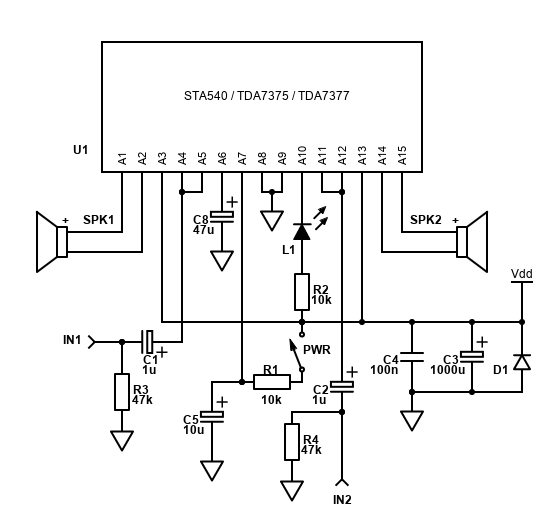
| # | Type | Quantity |
|---|---|---|
| U1 | STA540, TDA7375, TDA7377, or TDA7379 | 1 |
| R1,R2 | 10k ohm Resistor, ¼W Metal Film, 1% | 2 |
| R3,R4 | 47k ohm Resistor, ¼W Metal Film, 1% | 2 |
| C1,C2 | 1µF Capacitor, Polyester Film/Box (Best) or 16V+ Electrolytic | 2 |
| C3 | 1000µF Capacitor, 25V+ Electrolytic | 1 |
| C4 | 100nF Capacitor, 50V+ Ceramic X7R or MLCC | 1 |
| C5 | 10µF Capacitor, 25V+ Electrolytic | 1 |
| C8 | 47µF Capacitor, 25V+ Electrolytic | 1 |
| L1 | LED, high brightness | 1 |
| In L,R,SGND,+Vs,GND,SPK,DIAG | 2.54mm header 11-pin | 1 |
| Heatsink, cable, connectors | ~ |
This is the most useful option, so it's what I've built and tried. In bridge mode, the components needed are small and easy to obtain as no DC blocking capacitor is needed on the speaker outputs (this is because both outputs will be at ½ the voltage supply, so no DC current flows through the speaker).
Bridge mode gives the greatest output power, but it does not have the capability to drive 2 ohm speakers.
The gain of the STA540 in bridge mode is fixed at about 26dB - that's a voltage gain of 20 times, calculated as 10^(dB/20), so 10^(26/20) = 20). This means, it's quite sensitive and unlikely to need a preamp. With a 12V input power, the STA540 can drive an 8 ohm speaker (which is 4 ohm bridged) to about 8W RMS at 1% distortion. To calculate the voltage of this, it's V = √(8 * 4) = 5.66V RMS. Divide that by 20 and it's a 283mV RMS input signal required to drive the STA540 to maximum power, without distortion. I found the output from a smartphone or many other sources can easily drive it to clipping.
With a 20V PSU, 22W power output into 8 ohms is achievable at 1% distortion. That input signal to reach that power raises to 470mV, which is still an output most input sources can meet but if yours cannot, you'll need a preamp with perhaps 1.5 to 2x gain.
The STA540 is best with a custom PCB, and my PCB Building guide has information on how you can draw and etch a custom PCBs (showing a specific example for the STA540). The layout below shows how small it can be - that's 35mm x 29 mm. Note that R3 and R4 are not included in this layout, but can be accommodated easily enough.
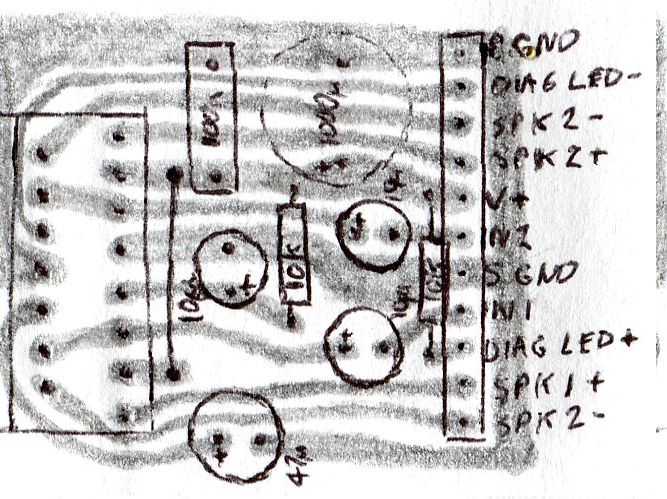
If you want to build on stripboard / Veroboard though, it can be done too!
The chip was not designed to fit into pre-made board, but by bending the front pins slightly to the left (very carefully), they'll align into 2.54mm stripboard just fine. I've not attempted this with the STA540 or related chips here, but have done with the TDA7266, see here.
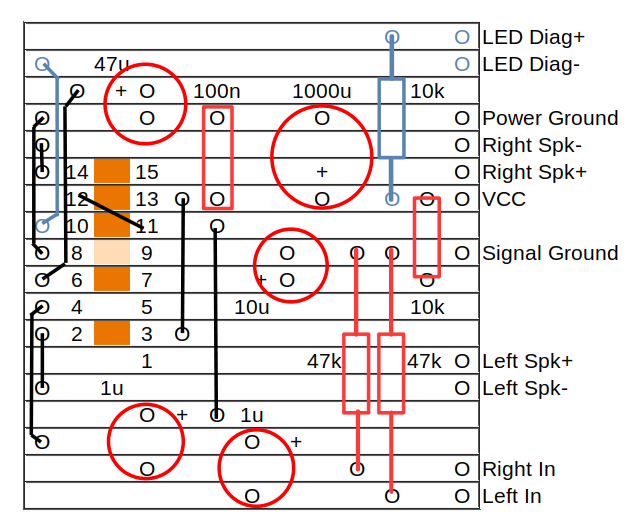
This suggested layout is similar to the layout I've built and tested for the TDA7266 and should work fine. It's designed so you can mount the board onto a heatsink without the board extending into the heatsink area. There is a lot of jumpers to install on the furthermost side though!
The areas in dark orange must be cut so that the strip is electronically separated. The light orange area can be optionally cut if your system layout requires the power and signal grounds to be joined at another point. I suggest joining them on the board though and keep this trace connecting pins 8 and 9 together.
You will also need to make a small jumper between pins 11 and 12 on the back of the board to make this connection. Do it carefully to avoid shorting any other traces.
The two 47k (R3 and R4) resistors leading to the left and right inputs are optional (bottom right). They prevent popping noises if you connect phono / 3.5mm inputs etc. whilst the amplifier is on, and also make it stable for a variety of sources (including mobile phone outputs) by providing a reasonable input impedance. You can leave them out, or optionally install them on the sockets directly.
The jumper, resistor and terminals in blue are also optional if don't want to have the diagnostics LED.
Stereo plus bridge drive / 2.1 application
The STA540 (unlike the TDA7297) has the flexibility to allow single ended outputs too. Each output pair can be configured in bridge or stereo single ended, allowing this 2.1 circuit to be made.
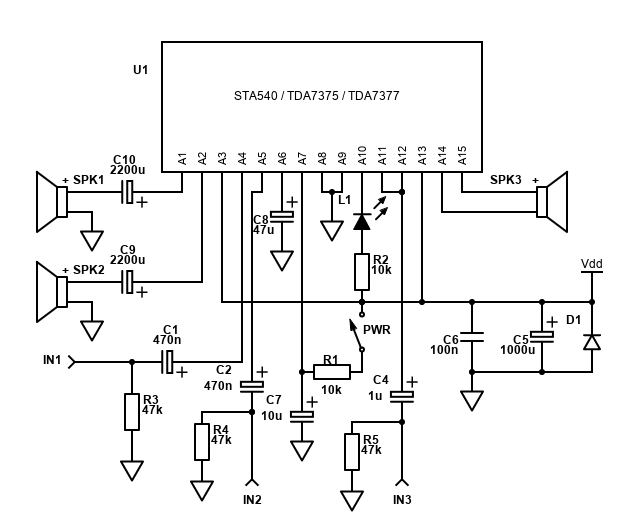
| # | Type | Quantity |
|---|---|---|
| U1 | STA540, TDA7375, TDA7377, or TDA7379 | 1 |
| R1,R2 | 10k ohm Resistor, ¼W Metal Film, 1% | 2 |
| R3,R4,R5 | 47k ohm Resistor, ¼W Metal Film, 1% | 3 |
| C1,C2 | 470nF Capacitor, Polyester Film/Box (Best) or 16V+ Electrolytic | 2 |
| C4 | 1µF Capacitor, Polyester Film/Box (Best) or 16V+ Electrolytic | 1 |
| C5 | 1000µF Capacitor, 25V+ Electrolytic | 1 |
| C6 | 100nF Capacitor, 50V+ Ceramic X7R or MLCC | 1 |
| C7 | 10µF Capacitor, 25V+ Electrolytic | 1 |
| C8 | 47µF Capacitor, 25V+ Electrolytic | 1 |
| C9,C10 | 2200µF Capacitor, 25V+ Electrolytic | 2 |
| L1 | LED, high brightness | 1 |
| In 1-3,SGND,+Vs,GND,SPK,DIAG | 2.54mm header 13-pin | 1 |
| Heatsink, cable, connectors | ~ |
I've not built it, but I can see some application for it because it would be ideal to make PC speakers with a single subwoofer or similar style system.
The subwoofer would be configured to drive frequencies below 150Hz (or up 200Hz if the satellite speakers are really tiny). In this 2.1 application, the subwoofer itself probably won't be very big itself, so will need more power than the satellites (even at that 150Hz crossover), and itself may need a bass boost at frequencies below 80Hz give or take.
The single bridge output of this 2.1 circuit would drive the subwoofer. In bridge mode, the output does not need DC blocking capacitors, so it won't attenuate low frequencies.
The two remaining outputs will be stereo single ended, therefore they'll be much lower power. If you are running all 8 ohm speakers though, you'll still get 7W into each satellite with a 22V PSU, and 27W into the subwoofer at 1% distortion (9W and 33W at 10%, but that's horrid). This will be pretty loud, but as the stereo single ended output will still be doing a lot of work into frequencies above 150Hz, there is the risk that you'll get distortion on the satellite speakers before the subwoofer.
The single ended outputs need DC blocking capacitors (C10 and C9). These block a DC current of ½ the voltage supply at the single ended output flowing through the speaker to the ground connection.
For the best bass response, these should be 1,000µF to 2,200µF for 8 ohm speakers, or 2,200µF to 3,300µF or greater into 4 ohm speakers. As the STA540 can drive the speaker output rail-to-rail, ensure that these output capacitors have a voltage rating greater than the power supply you are using. If you are driving small satellite speakers though and have a crossover point of 100Hz or more, than 220µF is required only. The input capacitors C1 and C2 can also be reduced to 100nF (this gives a cutoff of 53Hz).
The single ended input capacitors (C1 and C2) can be halved for the same frequency cutoff, so that's 470nF vs 1µF for the bridged input. That's because the input impedance of the STA540 is doubled for the single ended configuration inputs. To ensure stability with all sources though, I've added 47k resistors (R3 to R5) from the input to ground. Like before, these are optional.
Do note that the gain of the bridged output will be 26dB and the stereo single ended outputs will be only 20dB (half the voltage gain). This might be fine because the subwoofer will probably need to be louder anyway as speakers capable of handling low frequencies tend to be less sensitive, but do make sure that you include a potentiometer before the input capacitor C4 to adjust the gain of that channel.
With a voltage gain of only 10 (20dB), at 12V input power into an 8 ohm speaker the STA540 delivers just 2W RMS at 1% distortion. To calculate the voltage of this, it's V = √(2* 4) = 4V RMS. Divide that by 20 and it's a 200mV RMS input signal required to drive the single ended STA540 to maximum power, without much distortion.
With a 20V PSU, 5.8W power output into 8 ohms is achievable at 1% distortion. That input signal needs to reach to 340mV to get that power output.
That's somewhat less than the bridged input (which is 283mV), so you'll need level adjustments. Be careful of any passive circuits that attenuate frequencies before the amplifier. I would plan to build an active crossover and preamp for best results.
Although I think this circuit configuration may be of some use, especially for portable systems, if you want to build a more serious 2.1 setup I would instead suggest to use the STA540 in dual bridge mode instead for both satellites and get a mono bridge car radio chip for the subwoofer, such as the TDA7391.
Also note that if you are building a 2.1 system, you will still need to put a line level crossover in front of the amplifier to filter mid/treble from that bridge output, and filter bass from the dual single ended outputs (although the low frequencies will somewhat be attenuated by the DC blocking capacitors).
Quad single ended / quadraphonic application
The final configuration is to have all four outputs in single ended mode. This allows you to drive 4 speakers from a single chip.
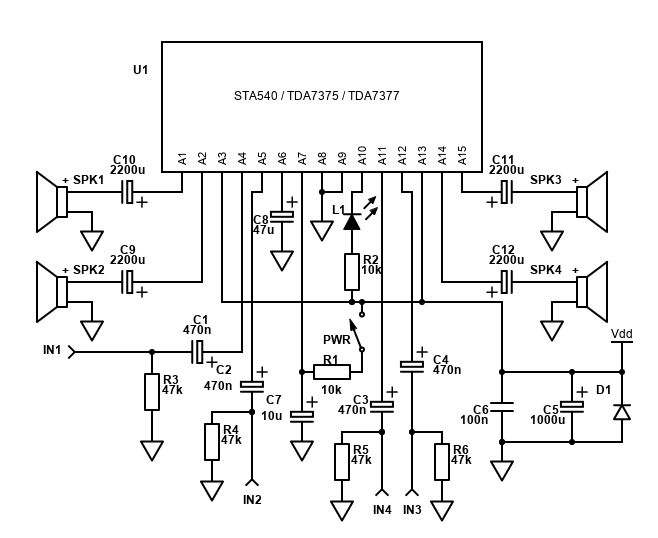
| # | Type | Quantity |
|---|---|---|
| U1 | STA540, TDA7375, TDA7377, or TDA7379 | 1 |
| R1,R2 | 10k ohm Resistor, ¼W Metal Film, 1% | 2 |
| R3,R4,R5,R6 | 47k ohm Resistor, ¼W Metal Film, 1% | 4 |
| C1,C2,C3,C4 | 470nF Capacitor, Polyester Film/Box (Best) or 16V+ Electrolytic | 4 |
| C5 | 1000µF Capacitor, 25V+ Electrolytic | 1 |
| C6 | 100nF Capacitor, 50V+ Ceramic X7R or MLCC | 1 |
| C7 | 10µF Capacitor, 25V+ Electrolytic | 1 |
| C8 | 47µF Capacitor, 25V+ Electrolytic | 1 |
| C9,C10,C11,C12 | 2200µF Capacitor, 25V+ Electrolytic | 4 |
| L1 | LED, high brightness | 1 |
| In 1-4,SGND,+Vs,GND,SPK,DIAG | 2.54mm header 15-pin | 1 |
| Heatsink, cable, connectors | ~ |
As can be seen, the schematic starts to look a little more complicated in this configuration due to the increase in parts, but there's not much advantage to this configuration because the output power is much lower at 7W per output at 1% distortion into 8 ohms at 22V, or just over 8W per channel into 4 ohm speakers from 18V, or 13W per channel into 2 ohm speakers from 18V (if you have this configuration!).
Whilst this circuit now has the advantage of driving 4 speakers, the disadvantage is every output now needs large DC blocking capacitors, one for each speaker (C9 through to C12). So that's four expensive and space consuming capacitors needed.
The input capacitors (C1 to C4) may be smaller because in single ended mode the input impedance is double, therefore 470nF instead of 1µF will give all bass frequencies. 330nF will also work fine. The 47k resistors (R3 to R6) are optional, but improve stability with all inputs.
Given the disadvantage of the output capacitors though, the datasheet does offer a solution of using just one output capacitor per speaker pair that would sit between the speaker negative terminals and the ground (figure 4 and 23 in the datasheet). Each pair of speakers would be terminated at the positive side of the capacitor, and the negative side would be in the power ground.
You still need to have two capacitors for four speakers in this configuration, but the capacitor can be smaller (470µF). As the datasheet suggests though, they'll be a degradation on the spatial image - meaning you'll hear the output of one channel on the other channel slightly.
I've two suggestions though.. either buy two STA540 chips instead and operate them both in dual bridge mode, or look at quad channel amplifiers such as the TDA7381, TDA7384, TDA7385, TDA7387, TDA7388... All are bridge amplifiers for car audio, but will perform well and again have minimal external components.
Either option won't be much more expensive, and it won't take up much more room but you'll get a far superior power output and even if you don't need the extra power, you can now use a lower voltage power supply instead.
With a voltage gain of all four speakers in this mode is only 10 (20dB). At 12V input power into an 8 ohm speaker the STA540 delivers just 2W RMS at 1% distortion into each speaker, and to get that maximum power a 200mV RMS input signal would be required (see calculation above).
Microprocessor control
If you want to use a microprocessor to control the standby and mute of this amplifier - it's possible, but a bit different from the TDA7297 / TDA7266 chips.
The datasheet tells you pin 7 is the standby pin and must be driven with a series resistor and a capacitor of 100nF from pin 7 to ground to smooth the on/off transitions.
Muting is also possible by driving pin 6, the SVR pin, with an NPN transistor. Figure 29 gives the circuit for both mute and standby application. Both mute and standby signals can be driven by 3.3V or 5V microprocessors, therefore the microprocessor can be an Arduino, PIC or similar MCU, or it can be the GPIO pins of a Raspberry Pi or similar computer.
Driving the signal high takes the amplifier out of standby, and again driving the mute line high takes the amplifier out of mute. I suggest a timing suggestion of 100ms to 200ms between the amplifier exiting standby and the amplifier unmuted to avoid any popping noises.
The diagnostics pin can also be fed to the input pin of a microprocessor too, allowing power to be cut in fault conditions, or muting on clipping (just ideas for programming).
For convenience, I've shown all three connections (pin 7 for standby, pin 6 for mute and pin 10 for diagnostics) in the schematic below, but removed the rest of the pin connections for clarity. This same setup applies to any of the three applications described above.
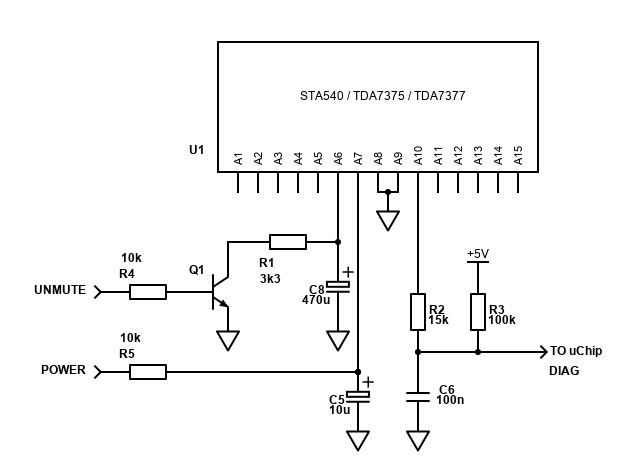
Note: I've not built and tested these chips on a microprocessor, therefore the above schematic is not verified, but should be fine. Contact me if you've verified it yourself.
Components
Like all amplifiers, the STA540 needs bypass capacitors C3 and C4 (C5 and C6 for the 2.1 and quad versions). That's a 1000µF or better electrolytic capacitor, and a 100nF ceramic or multi-layer ceramic (MLCC) capacitor. Make sure the electrolytic is oriented correctly with + in the positive power supply.
Both C3 and C4 need to be as close to the amplifier pins as possible, with C4 (the 100nF ceramic) being the closest. As pin 3 and 13 are quite far apart, for the best power supply bypassing, you may prefer to add a second 100nF capacitor (same as C4) from pin 13 to ground as well as pin 3 to ground.
C3 needs to have a voltage rating of a few volts or more greater than the power supply you want to use. Therefore, a 16V capacitor is fine for a 12V PSU, but if you want to go higher with the voltage, get a 25V or 35V rated capacitor. The datasheet suggests 1,000µF for C3, but if you have a good power supply with capacitance exceeding this already, then C3 could be dropped to 470µF or 220µF.
As the STA540 is a single supply amplifier, it generates a virtual ground internally that is half the supply voltage. This allows the audio input signal to swing above and below this virtual ground. It's a rail-to-rail amplifier too, so at maximum power this means the STA540 can drive the speaker output all the way from 0V to its supply voltage. This is why it can output more power for the same voltage than the TDA7297.
The input capacitors C1 and C2 (and also C3 and C4 for 2.1/quad applications) protect that DC voltage offset from reaching your input source. These are 0.47µF (470nF) input capacitors in the datasheet, but you can raise these to 1µF to get the best bass response. I used 2.2µF. Polyester is preferred for best audio quality, but an electrolytic works fine too and unless you're using this amp for the absolute best speakers in a quiet environment, you'll unlikely to notice the difference. The + pin of the electrolytic must be facing the amplifier pins.
The voltage the capacitor needs to handle is half the supply voltage plus the peak AC input (no more than 2V), a 16V rated capacitor is fine for C3 and C5, but 1µF electrolytic capacitors are usually 50V or 63V rated or higher anyway.
Note: If you've ordered a cheap STA540 from China / East Asia - not only are you probably getting a fake STA540 that doesn't perform as well, but you're also given multi-layer ceramic capacitors for C1/C2. These are not recommended for audio.
In the standalone applications (with no microprocessor), R1 is needed to limit the current applied to the standby pin. Because there's no audio in this resistor, it can be any cheap 10k resistor. C7 is an electrolytic capacitor that charges through this resistor and 10µF is given as the suggested value in the datasheet.
C8 is a capacitor connected from the pin 6 (SVR) to ground. It's used to determine the time the amplifier stays muted after receiving power, allowing the amplifier to be powered on with no pops on the speakers. Get a capacitor rated to ½ the voltage supply, though it's unlikely you'll get a 47µF capacitor under 16V.
Do not run this amp without a good heatsink, it will get extremely hot very quickly and shut down. Get a good heatsink, and if pushing the voltage to its maximum or 4 ohm speaker, get a really good heatsink! The heatsink internally connects to ground which shouldn't cause a problem for most applications, however if your using the amplifier on mains power and your case is earthed (it must be for safety), you may need a loop breaker to avoid hum caused by other equipment that is also earthed, and in this case the STA540 would need to be isolated from its heatsink in order to avoid shorting the earthed case to the amplifier power and signal grounds.
When mounting the amplifier chip to the heatsink, also use a line of thermal paste, and let the pressure of screwing it onto the heatsink push out the paste to cover the entire back of the tab. It's important to use thermal paste to improve the heat transfer, but do not use too much.
Making a 'system'
If you want to build your own stereo amplifier system, you'll need a little more than the circuit and components above.
- A power supply - see below, but suggest an external power supply
- A DC jack such as a standard 2.1mm jack. It should match the plug on the power supply
- A power switch, such as a slide switch, toggle switch or latching push button
- A power LED and current limiting resistor (you may have an LED in your power button you can use)
- 3.5mm jack input or phono sockets for connecting your source
- A dual gang potentiometer, 10k log is recommended
- Optional, but recommended, capacitors to block radio interference
- Optional, but recommended, a capacitor and inductor to improve PSU noise
- Optional, but recommended, capacitors in front of potentiometer to block DC
- If your speakers are separate from the amplifier, spring clips, female banana plug sockets or similar should be used to attach/detach the speakers
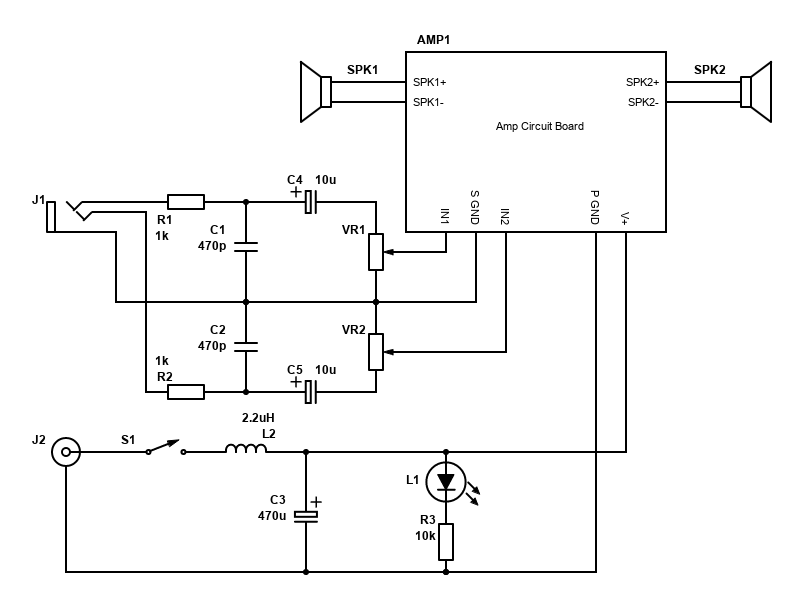
Since the fixed gain is reasonable, it's unlikely you'll need a preamplifier and you'll be able to use most sources directly. This could be your TV, smartphone, a Bluetooth audio module, Chromecast audio (if you can find it to buy) or many other devices.
When connecting all connections, tightly twist the related wires together. This is applicable to all related connections where there is a signal and a return, so twist the L/R input with the signal ground together, twist each speaker +/- wires together, and twist the voltage + supply and power ground together.
Twisting related flow/return wires together likes this both prevents them radiating interference, and also protects them from interference. Each twisted set in a system should be kept away from each other and if they must be close, let them cross at right angles and don't run them parallel to each other. This is to reduce hum.
The PCB layouts above have the signal and power grounds joined together at the board, therefore do not have these connecting anywhere else to avoid hum caused by ground loops. If you do have a wider system and have these power and signal grounds joined at another point, consider removing the join at the board and replacing it with a 10 ohm resistor, in parallel with a 100nF capacitor.
The potentiometer should be a dual gang one, so both channels are adjusted together. 10k Log type is ideal. It will have three pins per channel. The first pin will be the one connected to signal ground, the middle pin to the audio input and the final pin as the audio output. This will ensure that turning the volume control clockwise raises the volume, anti-clockwise lowers it.
Before the volume control are a 10µF capacitors on each signal (C4 and C5). These block any DC offset the source may or may not have. DC voltages cause the potentiometer to become noisy over time (particularly when adjusted), so the capacitors improve its life. We don't have to worry about any capacitor after the volume control because the capacitor is the first component in series with the input signal at the amplifier itself.
At the input socket are two RC low pass filter (one for each signal). The component values are not too critical here, it's just to ensure signals of MHz's are removed so with the combination of 1k ohms and 470pF (picofarads), frequencies above 340kHz are removed. This will remove any GSM pulsed buzz / interference from mobile phones, as well as any AM radio stations creeping in.
At the power supply, the switch is first, on the positive line. I suggest to get a latching push button switch with an LED built in for convenience but check whether the LED needs a resistor or not (some are 12V ready). Otherwise having a separate LED to indicate whether the power is on is useful. The value R3 should be adjusted to suit your power supply and LED type (search for LED resistor calculator).
Then there is a filter formed by a 2.2µH power inductor (capable of handling 6A current) and a 470µF capacitor (this must be a low ESR type). These are there to reduce the ringing/whining noise from noisy SMPS power supplies. Anything above 5kHz on the PSU is cut. You may not need the inductor if your power supply is quiet, but I still suggest the capacitor for smoothing the voltage.
Power Supply
I recommend, especially for beginners, that an external power supply is used. This should be a linear power supply or switching power supply that is suitable for audio/video use (i.e. a 12V or 19V laptop power supply). These types of power supplies are easy to obtain.
Be wary of cheap power supplies ordered from the far east and elsewhere because although they may work fine, they won't be safe in overload or other situations (lightning strikes etc.). The CE symbol on these devices is either fake or means 'China Export' and isn't the European certification that guarantees the product conforms with health, safety, and environmental protection standards.
With a 12V supply, this amplifier can give almost 8W into 8 ohms at a reasonable 1% distortion, or 14W into 4 ohms. For many applications this will be enough. Because there are two class AB amplifiers, this means the power supply will need to be 32W minimum (that's 2.66A output for 12V). More is needed for 4 ohms, I suggest 50W (4.2A for 12V).
19V (or 19.5V) power supplies for laptops can also be found. This will let the amplifier get to 20W per channel. Now we need to look for an 80W supply minimum, that's 4.2A at 19V. Higher will do no harm - my HP laptop has a 90W PSU giving 19.5V at 4.6A that would be perfect!
If you decide to build your own power supply, you can use a 12V AC 80VA transformer to get about 17V DC when rectified, or a 15V AC would push upwards of 21V DC. See the TDA2003 article for a suitable schematic, but bear in mind you will be working with mains electricity. The unregulated output from this should be fine, but if you want the best noise performance, using regulator capable of 5A or more (LM338T for example) with large heatsinks.
Performance
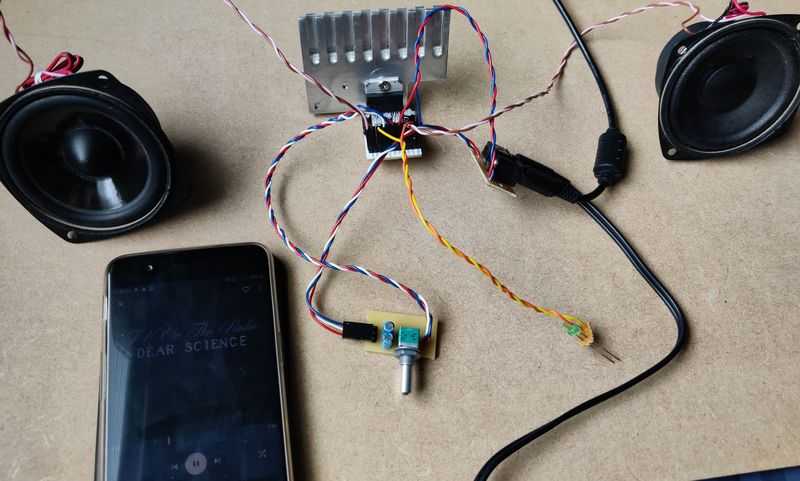
Above: First test of the STA540
Wired correctly, the STA540 delivers great audio. It sounds exceptionally good and is perfect for driving small speakers and even larger speakers. I think this chip is entry level hifi because of the audio quality and power output it is capable of. It requires a great deal more effort and cost to build a bigger hifi system with chips such as the LM3886 etc., and many applications just won't need the extra power those can give. I reckon you could build a damn good system with just one of these, and an even better system by bi-amplifying two of these chips. They're also a good consideration for a mutlichannel amplifier.
This amplifier is applicable for your battery-operated devices too! Its minimum voltage is 8V, so you'd need to put 3 to 4 lithium ion cells in series, or use 6x AA batteries. For lower voltages, consider the TDA7266 instead.
TDA7375 application
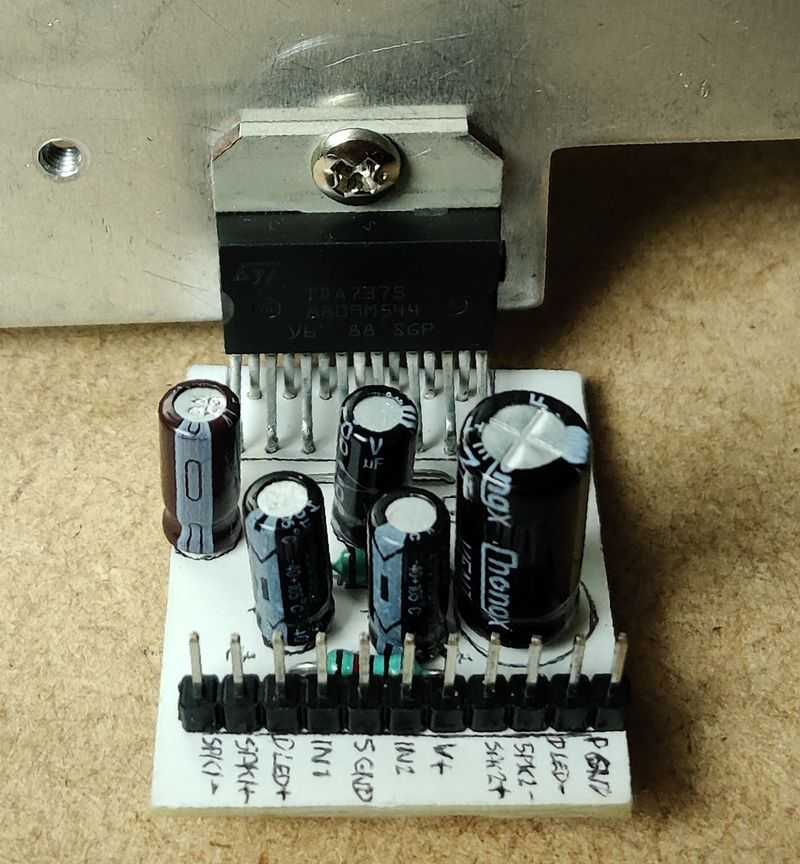
Quick facts TDA7375
- Power output: 2x 25W into 4 ohms at 10% 1kHz distortion with power supply 14.4V
- Power output: 2x 7W into 4 ohms at 10% 1kHz distortion with power supply 14.4V
- Power output: 2x 38W into 4 ohms at 10% 1kHz distortion with power supply 18V
- Power output: 4x 11W into 4 ohms at 10% 1kHz distortion with power supply 18V
- Power output: 2x 30W into 4 ohms at 1% 1kHz distortion with power supply 18V
- Power output: 4x 8.5W into 4 ohms at 1% 1kHz distortion with power supply 18V
- Gain: 26dB fixed in bridge mode, 20dB fixed in single ended mode
- Power supply: 8V to 18V* single supply
- Class AB
- Datasheet available here
The TDA7375 will drop right into the same circuit board for the STA540 without any change in components. I've also built the TDA7375 and can confirm its greatness.
Therefore, read the above guide since it is just as appropriate.
The performance of the chip looks to be similar as the STA540, but the maximum operating voltage is a lower 18V vs the 22V of the STA540. Its application is for car radio, but that doesn't mean it sounds bad, and it actually sounds really good - just like the STA540! The single ended distortion is 0.02%, which is the same as the STA540, and even high-end chips like the LM3886 or TDA1514. It's 0.03% when bridged (which the STA540 doesn't quote). You won't be able to hear this level of distortion.
No power output into 8 ohms is quoted by the datasheet, but I've tested it on 8 ohm speakers and it works fine and will deliver the same amount of power as the STA540 (so see above for power outputs).
* With 8 ohm speakers, you might be able to push the supply voltage higher (like STA540). I found my chip shut down when powering 8 ohm resistors at around 21.3V. This opens up the possibility of using the TDA7375 from laptop power supplies too, but only when powering 8 ohm speakers.
The TDA7375 does seem to be able to survive a non-operating voltage of 28V vs the 24V of the STA540. This is to make it more resilient in the car environment.
You might find the TDA7375 listed as a TDA7375AV, E-TDA7375AV, E-TDA7375V or TDA7375V.
The TDA7375AV datasheet here may appear to be an improved version of the chip which claims to reach 2x 26W into 4 ohm speakers at 10% THD with 14.4V, vs 2x 25W for the TDA7375 - however the electrical characteristics section says 25W again. Pay no attention to the headline EIAJ or max power figures - these are for saturated square waves, which are far away from music or speech.
TDA7377 application
Quick facts TDA7377
- Power output: 2x 20W into 4 ohms at 10% 1kHz distortion with power supply 14.4V
- Power output: 2x 6W into 4 ohms at 10% 1kHz distortion with power supply 14.4V
- Power output: 2x 30W into 4 ohms at 1% 1kHz distortion with power supply 18V
- Power output: 4x 8.5W into 4 ohms at 1% 1kHz distortion with power supply 18V
- Gain: 26dB fixed in bridge mode, 20dB fixed in single ended mode
- Power supply: 8V to 18V single supply
- Class AB
- Datasheet available here
The TDA7377 is remarkably similar to the TDA7375 and again will drop right into the same circuit board for the STA540 without any change in components. I've not built or tested a TDA7377 chip.
Therefore, again read the above guide since it is just as appropriate.
Curiously, the ST datasheet does not provide any graphs to see the output power vs voltage, but its electrical characteristics suggest an output power at 14.4V into 4 ohms at 10% THD of 20W. This is less than the 25W of the TDA7375 in the same conditions. The Linear Integrated Circuit datasheet (linked above) has more info, but the bridged output lines go off the top of the graph!
You might find the TDA7377 listed as an E-TDA7377, TDA7377A, TDA7377V, or TDA7377H (the last one is horizontally oriented).
TDA7379 application
Quick facts TDA7379
- Power output: 2x 38W into 4 ohms at 10% 1kHz distortion with power supply 18V
- Power output: 2x 34W into 8 ohms at 10% 1kHz distortion with power supply 22V
- Power output: 4x 11W into 4 ohms at 10% 1kHz distortion with power supply 18V
- Power output: 2x 18W into 8 ohms at 1% 1kHz distortion with power supply 18V
- Power output: 2x 8W into 8 ohms at 1% 1kHz distortion with power supply 12V
- Gain: 26dB fixed in bridge mode, 20dB fixed in single ended mode
- Power supply: 8V to 22V single supply
- Class AB
- Datasheet available here
The TDA7379 does not seem to be available anymore, therefore I suggest you do not buy it. The power outputs are the same as the STA540, so it appears to be its predecessor, so read all about the STA540 above.
Mono application?
All the above chips have quad outputs, or dual bridged - but what if you just need a mono output?
You can of course still use these chips by grounding the unused input via the input capacitor (for example C2 would be between pins 11/12 and the ground). The second speaker output would be left disconnected, so pins 14/15 connect to nothing.
There are mono bridge amplifiers though. The TDA7391 and TDA7396 are two possible alternatives that still have simple circuits. The TDA7391 can drive 3.1 ohm speaker, and the TDA7396 can drive even a 2 ohm speaker.
